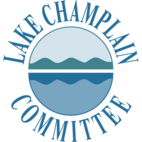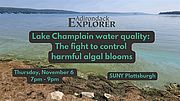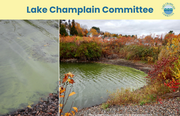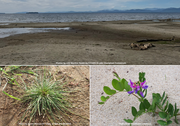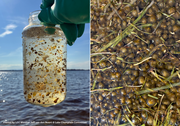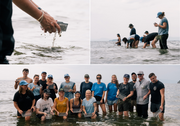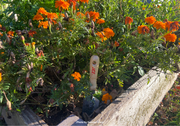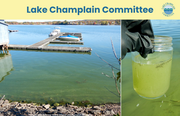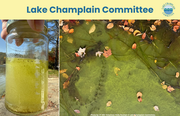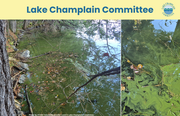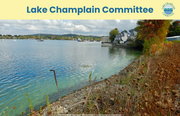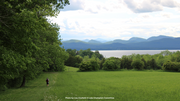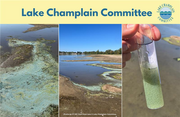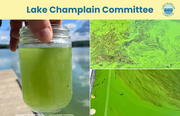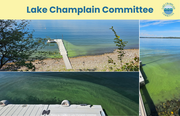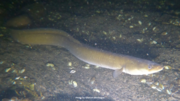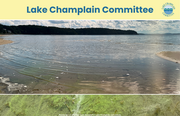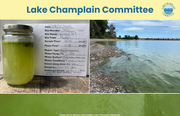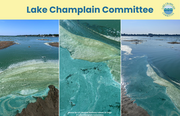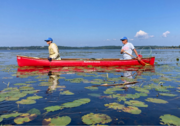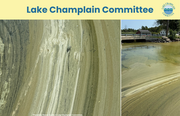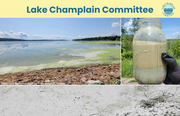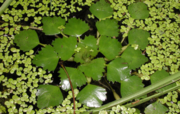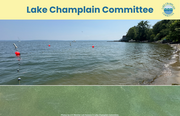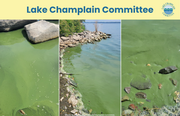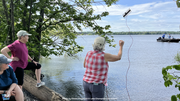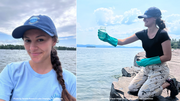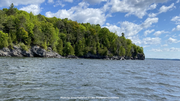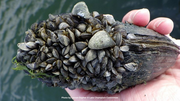Join ADK Explorer's water reporter Zach Matson as he moderates a panel of water quality experts and environmental leaders (including LCC Executive Director Jenny Patterson!) tackling Lake Champlain's persistent water quality challenges. For over three decades, communities and advocates across Lake Champlain’s sprawling watershed have sought to control phosphorus, a key nutrient powering harmful algal blooms in the lake and fueling more public beach closures as summers get hotter. Read...
News from Selected Month
Week 19 of the cyanobacteria monitoring season (10/19 - 10/25/2025), we saw a high alert bloom at St. Anne’s Shrine in Isle La Motte, benthic cyanobacteria globules at Holcomb Boat Launch, subtle traces of cyanobacteria at Graveyard Point West in North Hero, lingering bloom conditions in Lake Memphremagog, and reports of clear water throughout the lake. Read...
After the summer floods of 2023 and 2024, many in the Lake Champlain basin watched nervously for a third deluge this past summer. Instead, we got the opposite extreme: a drought, which brought lake levels to near record lows and exposed previously submersed rocks and beaches. Low lake levels have many implications, including a loss of shallow water habitat and new navigational hazards for boaters. Turning away from the water and toward the beach, those exploring the basin may have encountered an unexpected ecological consequence of the drought on shore as well. Read...
This summer, the Lake Champlain Committee partnered with Tetra Tech and launched a new project aimed at better understanding and monitoring benthic cyanobacteria blooms. Benthic cyanobacteria are a type of cyanobacteria that grow on lake bottoms and shorelines, in Lake Champlain and nearby inland lakes. By combining community science with DNA and toxin tests, we can create a local monitoring plan that can help protect ecosystems and public health. Read...
Back in August, LCC partnered with the team at Foam Brewers to survey for the invasive golden clam (Corbicula fluminea) at North Beach in Burlington, VT. LCC Water and Science Program Coordinator Lindsey Cookson trained the team on how to survey the shoreline and discussed how the introduction and spread of this invasive species can harm aquatic ecosystems by out-competing native species, altering the nutrient cycle, and disrupting habitat. The good news: no golden clams were detected during the survey! Foam generously donated all proceeds from sales of their beer “Ripple”—an annual brew they sell to benefit lake protection—on tap at the brewery to support LCC’s work. Proceeds from can sales supported the Conservation Law Foundation and the ECHO Leahy Center for Lake Champlain. We are grateful to their staff for joining us and for their continued support in protecting Lake Champlain. Read...
Volunteers are essential to LCC’s work, whether they are tossing rakes as CHAMP aquatic invasive species patrollers, advocating for lake health to legislators and state agencies, or diligently photographing and reporting cyanobacteria conditions each week. This September, we celebrated our volunteers at gatherings in our Burlington office and at Ballard Beach in Westport, New York, providing these dedicated individuals with the opportunity to meet each other and catch up with us. Read...
For the price of a pasta entree, you can get detailed insights on the makeup of your soil. A soil test can tell you about the nutrient levels, organic content, and pH (the soil acidity or alkalinity) of your lawn or garden area and what you need for healthy plant growth. It is important to test your soil before applying fertilizer, since you may not need certain nutrient additives like phosphorus which can end up polluting surface waters and driving cyanobacteria blooms in Lake Champlain as soil erodes. The University of Vermont Agricultural and Environmental Testing Lab offers basic soil testing for just $17 (and you don’t need to be a Vermont resident to bring in a sample!). Read...
In week 18 (10/12-10/28/2025) of the cyanobacteria monitoring season, we saw the lingering late-season bloom in North Hero, the vibrant green waters at Shelburne Pond, a swirl of green and teal at Graveyard Point, a bright surface bloom at North Harbor, and the serene fall waterscape along a clear shoreline. Read...
Even as fall advances and temperatures turn cool and crisp, cyanobacteria blooms continue to appear across Lake Champlain and Vermont’s inland waterbodies. This week, only low-alert blooms were observed in Lake Champlain, occurring in the Inland Sea and Main Lake North. Three inland Vermont lakes experienced blooms, with Halls Lake showing a high number of high-alert blooms. Read...
With fall now underway, cyanobacteria blooms are still being observed in multiple sections of Lake Champlain and in inland Vermont waterbodies. This week, we saw a mixed bloom with different types of cyanobacteria at Graveyard Point, patchy cyanobacteria mats at North Harbor, persistent bright green blooms at Shelburne Pond, and a muted green cyanobacteria blending into the fall-colored surroundings at Lake Memphremagog.
Even with cooler temperatures and autumn colors setting in, cyanobacteria blooms are still showing up across Lake Champlain and nearby Vermont waterbodies. During Week 15, the Main Lake South experienced a notably high amount of blooms, while Lake Memphremagog saw several high alert conditions. Other areas with reported blooms included the Inland Sea, Main Lake Central, Main Lake South, Main Lake North, and inland lakes such as Shelburne Pond. Read...
The products we use to encourage prolific lawn growth may end up fueling less-welcome species, including cyanobacteria, when they end up in Lake Champlain. Read...
Although fall is officially here, cyanobacteria blooms were still observed across Lake Champlain and several inland Vermont waterbodies during Week 14. While the overall number of reports was lower, blooms occurred in several key areas on Lake Champlain, including the Inland Sea, Main Lake North, Main Lake South, Missisquoi Bay, and St. Albans Bay, as well as in Vermont waterbodies like Shelburne Pond and Lake Memphremagog. Read...
This week we saw a paint-like bloom at Venise-en-Québec shoreline, a green sheen bloom at Black Bridge in St. Albans Town, a faint green haze at North Beach in Burlington, an intense bright green layer at the U.S. Coast Guard Boat Access Ramp in Burlington, and clear waters at Alburgh Dunes State Park. Read...
During Week 12 (8/9 - 9/6/2025) of the cyanobacteria monitoring season, we saw paint-like green bloom at Philipsburg Boat Launch, dense mats coating the shoreline at Philipsburg, vibrant green waters at North Hero Marina, bright teal and green cyanobacteria patches at Parc Jameson, and speckled green patterns at Rock Point Eagle Bay. Read...
Under a velvety dark sky on the night of a new moon, an American eel (Anguilla rostrata) slithers from her watery home in Lake Champlain to embark on a fateful mission. To mate, she must venture on a journey that stretches north through the Richelieu River, down the broad St. Lawrence, into the cold sweep of the North Atlantic, and then thousands of miles south to the Sargasso Sea near Bermuda. Read...
This week we saw teal tinted waters at Parc Jameson, patches of green from a low alert at Graveyard Point East, green waters at Shelburne Pond, tiny cyanobacteria at Black Bridge in St. Albans, and specks of cyanobacteria at Graveyard Point West. Read...
This week we saw bright green surface accumulations at Shipyard in Highgate Springs, thick swirling scums at Philipsburg, nearshore pea soup conditions at Lakeshore Park in Alburgh later in the week, patchy shoreline blooms at Graveyard Point in North Hero, and clear water conditions at Burlington’s Triangle Beach. Read...
This week, we continued to see blooms in Missisquoi Bay and the Inland Sea, with additional reports scattered throughout the lake. While some areas remain clear, cyanobacteria is still present in several locations. Read...
For most of human history in the Lake Champlain region, paddling was a way of life, not just a means of recreation. Read...
We saw blooms this week in the Inland Sea, Missisquoi Bay, Malletts Bay, and Main Lake North, along with reports from Lake Carmi and other inland lakes. Several sites also showed signs of blooms beginning to break down, with teal hues, wispy white streaks, and patchy surface accumulations. Read...
We saw an increase in blooms during Week 7 of the cyanobacteria monitoring season (7/27 - 8/2/2025), with numerous reports coming from Missisquoi Bay and St. Albans Bay. Several sites also showed signs of blooms beginning to break down, with teal hues, wispy white streaks, and patchy surface accumulations. Read...
Join LCC and the Milton Historical Society for a program on aquatic invasive species!
Date: Wednesday, August 6 2025
Time: 6:30 – 8pm
Location: Sandbar Wildlife Management Area Area, Milton (Across the street (Route 2) from Sandbar State Park)
For this event, we will give an overview of invasive species in Lake Champlain and discuss how they got there and ways to prevent their introduction and spread to new areas. We will then learn about some of these species: how to identify them and tell them apart from native aquatic plants, and best ways to manage them. Then we will also do a hands-on activity to “hunt” for invasives by tossing aquatic rakes into the water and inventorying what we rake up—surveying helps us better understand who is living in our lake and how invasive species are spread.
Thank you for signing up to receive the Lake Champlain Committee (LCC) Cyanobacteria monitoring reports! In this email, you will find details of Week 5 monitoring results. Click on the links to see a dense jar of cyanobacteria from a high alert bloom at Black Bridge in St. Albans Bay, meet dedicated volunteers Lois and Richard Rawson in our Monitor Spotlight, view a Category 2 bloom at Crater Club in Essex, NY, examine a Category 3 surface bloom from Venise-en-Québec, and check out clear conditions at Allen Brothers Marsh in Westminster, VT. Read...
Thank you for signing up to receive the Lake Champlain Committee (LCC) Cyanobacteria monitoring reports! In this email, you will find details of Week 4 monitoring results. Click on the links to see a dense bloom at Corlear Bay, meet part of the Burlington Parks team in this week's Monitor Spotlight, view striking swirls of blue and green in Keeseville, check out a thick surface bloom at Shelburne Pond, and observe a high alert bloom in Whiskey Bay. Read...
The day after a heat wave swept through the Champlain Valley, the clouds lifted to reveal a brilliant sunset over Lake Champlain. As LCC staff, board members, volunteers, colleagues, and friends gathered at the St. John’s Club in Burlington, the setting sun served as a fitting metaphor for the occasion: the retirement celebration of former LCC Executive Director Lori Fisher. Much like the sun, Lori supplied life-force energy to LCC for over 40 years. Read...
In 2023, LCC started the Champlain Aquatic invasive Monitoring Program, aka CHAMP. Through this program, we train, support, and empower community scientists from all around Lake Champlain to identify and survey for aquatic invasive species. In 2024, a CHAMP volunteer made the first discovery of a new invasive species in Lake Champlain, the golden clam (Corbicula fluminea). As CHAMP enters its third season, we have grown from seven to over 30 volunteers, covering dozens of sites. After hosting an online training, we took to the road on a CHAMP training tour, from the lake’s southernmost point in Whitehall, NY all the way up to its northern reaches in Missisquoi Bay. The goal was to meet volunteers near the spots they plan to survey and to give a hands-on introduction to the species they’ll be looking for. Traveling with a cooler full of specimens – some pressed and laminated, others preserved in formaldehyde, and a few live specimens for good measure – we “got into the weeds” of aquatic plant identification. Read...
We are thrilled to welcome Serena Buono to the LCC team as our summer intern! Always a fan of the lake and the comforting skyline of tall mountains, Serena decided to move up from her home in Long Island, NY to study and protect the ecosystems she loves. At the end of this summer, Serena will proudly enter her senior year at the University of Vermont, majoring in Sustainability, Ecology, and Policy with a concentration in environmental policy. Her passion lies in advocating for large-scale policy changes while invigorating citizens at the grassroots level to become more involved with the environmental protection movement. Read...
We compiled an update on key legislation in Vermont and New York on issues for Lake Champlain - including road salt and agricultural pollution. Read...
Lake Champlain teems with movement in the summer: fish splash, osprey dive, and kayakers paddle. Waters warmed by the July sun seem to suffuse lake life with motion. Yet there is an animal that remains slow, if not completely still, amidst the activity of the season: the freshwater mussel. Most of us are familiar with the invasive zebra mussel. But what about the mussels native to Lake Champlain? Freshwater mussels are under threat throughout North America, including in Lake Champlain. There are 18 species of freshwater mussel in Vermont, 15 of which are considered rare or uncommon, and 10 of which are listed under the state endangered species law. Read...
